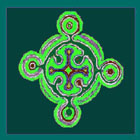Here is acclaimed architect Christopher Alexander's four-volume masterwork: the result of 27 years of research and a lifetime of profoundly original thinking.
Alexander has advanced a new theory of architecture, matter, and organization, that has attracted thousands of readers and practical followers throughout the world. His grasp of the fundamental truths of traditional ways of building, and his understanding of what gives life and beauty and true functionality to towns and buildings, is put forth in a context that sheds light on the character of order in all phenomena. Taken even further, hundreds of examples are given to show how the theory has been put to use in his many projects around the world.
The four books of The Nature of Order redefine architecture for the 21st century as a field, as a profession, as practice and as social philosophy. Each of the books deals with one facet of the discipline. This worldview provides architecture with a new underpinning, describing procedures of planning, design, and building, as well as attitudes to style, to the shapes of buildings, and to the forms of urbanization and construction. Here is an entirely new way of thinking about the world. As one writer has expressed it, "The books provide the language for the construction and transition to a new kind of society, rooted in the nature of human beings."
The four books, each one an essay on the topic of living structure, are connected and interdependent. Each sheds light on one facet of living structure: first, the definition; second, the process of generating living structure; third, the practical vision of an architecture guided by the concept of living structure; and fourth, the cosmological underpinnings and implications brought into being by the idea of living structure.
The books offer a view of a human-centered universe, a view of order, in which the soul, or human feeling and the soul, play a central role. Here, experiments are not only conceivable in the abstract Cartesian mode, but a new class of experiments relying on human feeling as a form of measurement, show us definitively the foundation of all architecture as something which resides in human beings. Whether this "something," which is demonstrated and discussed throughout the four books, is to be regarded as a new entity underlying matter, or what used to be called the "soul," is left for the reader to decide.
Taken as a whole the four books create a sweeping new conception of the nature of things which is both objective and structural (hence part of science) - and also personal (in that it shows how and why things have the power to touch the human heart). A step has been taken, through which these two domains - the domain of geometrical structure and the feeling it creates - kept separate during four centuries of scientific thought, have finally been united.
The four volumes can be read separately, independently, and in any order. However, it is together as a whole that they have their greatest impact. For each book explores comprehensively different aspects of the coherence of our universe, and brings us at last to being at one with it.
These concepts reach far beyond the field of architecture. Scholars and practitioners in many fields are finding the relevance of these ideas to their own areas of study and practice - physics, biology, philosophy, cosmology, anthropology, computer science, and religious studies, to name a few.
For a description of each of the four books, please use these links.
A comprehensive summary of "Empirical Findings from The Nature of Order," can be found at
www.livingneighborhoods.org/library/empirical-findings.pdf
"Alexander intends his work on architecture not only for architects, but for people who live in architecture and can be ennobled by it"
Eric Buck, Professor of Philosophy, Montana State University at Billings
"Alexander is proposing a brilliant new sweeping idea that is both revolutionary and - only in hindsight, after one has read his extraordinary Opus - obvious. For it really cannot be any other way. Every thinking - no, every feeling - creature who wants to know our cosmos and his/her unique role in it needs to read these books."
Andrew Ilachinski, Ph.D., Theoretical Physics; editorial board, "Journal of Cellular Automata"
|
The four volumes have been written so that each stands alone as an independent book, and may be read without benefit of the others.
The full meaning of the four books, and the architectural, social, and cosmological scheme they introduce, can only be understood by seeing the interplay of these four complementary points of view.
|
|
|

